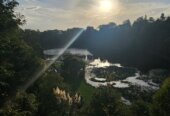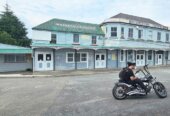As interest grows in local archaeological discoveries, Cambridge Historical Society president Grant Middlemiss is keen to encourage people to join the group. “This area was the centre of so much habitation… there are more and more developments underway around Cambridge. There will be more finds like this … that excites me.”

Cambridge Historical Society president Grant Middlemiss with Ngati Koroki Kahukura representative Poto Davies.
Details around centuries-old Maori fertility and birthing traditions were explained to a group of Cambridge Historical Society members when they visited the site of a Maori birthing unit that existed roughly 500 years ago.
Archaeologists believe the site once housed an extensive birthing area – whare marama. Excavations done last year exposed evidence of widespread garden plantings, large and small storage and firepits, walled areas and spaces where people would have been involved in the birthing process.
An agreement between the private landowner and mana whenua has resulted in the site being blessed by iwi, fenced and grassed over pending formal registration as ‘historic’. Iwi hope it can eventually be turned into a place where children can play, and where a diorama will tell the story of the area.
The Cambridge Historical Society’s field trip last weekend was to the appropriately-named Whare Marama Drive in Pukekura Estate off Roto-o-Rangi Drive. It was led by society president Grant Middlemiss and addressed by members of the Ngati Koroki Kahukura iwi, including the co-chair of Sanctuary Mountain Maungatautari Poto Davies, and Ellen Tupaea, a Maori midwife of Tuwharetoa descent who married into Ngati Koroki Kahukura. She has been acting as kaitiaki (guardian) of the site.
Davies said a whare marama, known in the Maori culture as a ‘moon house’, was named for its relationship with a woman’s fertility cycle and the moon phases. She said much of what had been excavated validated stories she had heard from her own mother, and she believes the site may still have been working in the early 1800s.
“We found obsidian lying everywhere … that was something we hadn’t seen anywhere else.” Obsidian was highly prized and often associated with toolmaking.
The whare marama would have been built against a large tree intended to provide physical and spiritual support to the women, Davies said. The placenta would traditionally have been buried in a pit beneath the tree, and it is likely that stillborn infants would have been similarly buried as they were historically treated as whenua (afterbirth), she said.
Both menstruation and pregnancy were considered sacred, with a deep reverence shown to Maori women, said Ellen Tupaea. They were provided with the best foods prepared in specific firepits; different pits being used for the preparation of fish, meat, potatoes, greens and so on.
“In our Maori culture, there would have been a big tree with a pit behind it … gardens would have been all around the site. There would have been hundreds of gardens,” she said. Smaller firepits inside the whare suggested the presence of areas where water would have been steamed, perhaps with the additions of rongoa (medicine) to assist labouring women, who gave birth standing or squatting rather than lying down.
“This place would have been known as somewhere special … people would have come from all around the area,” she said. “It wasn’t here just because it was a nice place, but because it had significance in terms of where it is.”
Tupaea said while she had heard about whare marama, she has never seen one.
“No other whare marama has been found intact like this in New Zealand. It is very special.”
Want to know more? Contact Grant Middlemiss on 021 360 840, or at [email protected].








